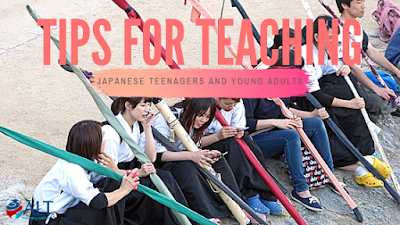Bio: Lina Gordyshevskaya graduated from the University of Edinburgh in 2015 earning an MA with honors in Scandinavian Studies. She obtained a CELTA in 2016 and Delta Module 1 in 2018.
Throughout her career, she has taught YL (young learners), teenagers, and adults of various levels in different contexts, including conversational schools and universities. Currently, she is teaching Business English at an IT-company in Tokyo and loves her job. She writes regularly for her blog, Side Notes on ELT.
Think of a typical Japanese teenage learner. You have probably come across some of them. Quiet and unresponsive, they never look at you and seem uninterested in whatever is going on in the classroom. All your questions are met with deafening silence. Little by little, you start feeling like you are banging your head against a brick wall until one day you realise that you have had enough.
The worst thing you can do in this case is to be quick to judge and give up on this whole situation. Yes, Japanese students are remarkably silent, but let us look at some reasons behind their silence.
Jim King (2014) stated in his research paper on social anxiety and silent behaviour of Japanese learners that the main reason is their cultural background. He wrote that in Japan, reserved behaviour is ‘culturally acceptable and positively regarded’ (p.234). Japan is a very high-context nation which means that one has to read between the lines. Less is said, but more is meant. The Japanese tend to place a higher positive value on silence in comparison to overt verbalisation (ibid).
Seiko Harumi (2001) added one more explanation. According to her, Japanese students’ use of silence is the result of the pedagogy of foreign language teaching including curriculum design and the methods used in teaching.
Indeed, Japanese classrooms are rather teacher-centred.
Foreign languages are taught starting with grammar and vocabulary, and the emphasis is put on receptive skills rather than productive.
In a country where an individual’s social status and position in the social hierarchy are important, students are seen as subordinates and their role is ‘to listen, observe, and learn’ (Atkinson, in Banks, 2016) and not to express their opinions. Of course, nowadays, this is changing but there is still a long way to go.
Taking into an account the abovementioned reasons, we can say that there are definitely quite a few challenges that foreign teachers are facing when teaching in Japan.
The question is what they can do about it. What can you do about it?
1. Problem: Your students avoid eye contact. When you speak, they often stare at their desks, but they will not look at you.
Solution: I would say that the only way is to accept it and take it calmly.
2. Problem: You asked your students if they understood your instructions / explanations. They all said yes or nodded but when you told them to start with the task it appeared that some of them did not understand what to do.
Comment: In Japanese culture, there is a concept of honne as opposed to tatemae. Honne is what an individual actually feels and thinks and tatemae is what they show to the public. It is very important that one keeps the face no matter what. Admitting out loud that there is something you did not understand is unacceptable and even humiliating from a Japanese person’s perspective.
Solution: Learn to read their faces. Many students will not say ‘no’ directly, but they will still look a bit confused. If this is the case (i.e. if you see some confused looks on their faces), give instructions / explanations once again but more slowly. You can also ask stronger students to translate your instructions into Japanese for those students who seem lost.
Another option is to learn some basic Japanese. Before starting with the task, those students who do not understand what to do will most likely whisper something like ‘What are we supposed to do? I didn’t understand’ to their neighbours, so you can act on this.
3. Problem: You ask them to share their opinion, and they freeze.
Comment: They want to give the right answer, but they do not know which is right. Giving a wrong answer means to lose your face, so instead of taking a risk they prefer to keep silence and avoid a potentially embarrassing situation. Another reason is that they are not used to expressing their opinions because they have hardly ever been asked to do that before.
Another reason could be that they are afraid of making errors, e.g. using wrong grammar, or they simply cannot find the right words. Many Japanese people have an erroneous belief that they should either speak perfect English or not speak it at all.
Solution: Instead of making them answer your questions directly, ask them to discuss the questions in pairs. You can walk around and comment on some interesting ideas you hear.
After a while when your students get used to this kind of interaction start asking them to report their ideas back to you. At first, they will struggle, but it is easier to repeat something you have already said rather than coming up with an idea on the spot.
After some time you will notice that they need less time before reporting. It took my students roughly seven weeks to get used to it, but eventually, they could do it easily and with little hesitation.
Make sure that you explain clearly that mistakes are okay and that the main idea of communication is mutual understanding rather than linguistic perfection (even if you yourself somewhat disagree with this).
4. Problem: A variation of the previous one, but a more severe one where your students do not want to communicate with each other either.
Solution: Instead of making them speak, why not ask them to write their answers down? Give each student a small whiteboard and a marker and see if it works. After all, communication does not necessarily have to be oral. After a while, when they get used to you and your classes, you can try encouraging them to become more verbal.
5. Problem: Your students smile all the time and seem to be positive, but one day, you overhear that some of them were complaining about your classes.
Comment: Smiling does not mean that they like you and enjoy the lesson. They are just being polite. They are not doing it on purpose – they just do not want to discomfort you. In Japan, people avoid being direct as this might offend other people. However, this does not mean they do not want to give feedback.
Solution: What you can do is to ask them to write down how they feel about today’s class, e.g. what they liked and what they found difficult. My students were quite keen on this and shared many difficulties they experienced. By knowing more about their feelings and learning issues I was able to assist them more effectively.
And once again, learn some Japanese to be able to understand their real attitude from what they say to their classmates.
While all of the above might alarm you, one thing you should know is that after several weeks, your students will get used to you and become more open and relaxed.
They might even start being honest about not understanding something and ask questions.
Just be patient and attentive to their needs, show them that you are sensitive to their fears and difficulties they experience and create a comfortable atmosphere.
Teaching is a rewarding profession, and teaching in Japan might be one of the best experiences in your life. You are the teacher, and everything is in your hands.
References:
Banks, S. (2016). Behind Japanese students’ silence in English classrooms. Accents Asia, 8 (2), pp. 54-57.
Harumi, S. (2001). The use of silence by Japanese EFL learners. JALT Conference proceedings.
King, J. (2014). Fear of true self: Social anxiety and the silent behaviour of Japanese learners of English. In K. Csizér & M. Magid (eds.), The impact of self-concept on language learning. Bristol, England: Multilingual Matters.
Don’t have any ideas? We have a list of topics to write about that need a writer. Email in your interest to write and we can set you up.
For upcoming blogs see the blogs tab here:



